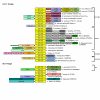Phylogenomic analysis of the GIY-YIG nuclease superfamily
- PMID: 16646971
- PMCID: PMC1564403
- DOI: 10.1186/1471-2164-7-98
Phylogenomic analysis of the GIY-YIG nuclease superfamily
Abstract
Background: The GIY-YIG domain was initially identified in homing endonucleases and later in other selfish mobile genetic elements (including restriction enzymes and non-LTR retrotransposons) and in enzymes involved in DNA repair and recombination. However, to date no systematic search for novel members of the GIY-YIG superfamily or comparative analysis of these enzymes has been reported.
Results: We carried out database searches to identify all members of known GIY-YIG nuclease families. Multiple sequence alignments together with predicted secondary structures of identified families were represented as Hidden Markov Models (HMM) and compared by the HHsearch method to the uncharacterized protein families gathered in the COG, KOG, and PFAM databases. This analysis allowed for extending the GIY-YIG superfamily to include members of COG3680 and a number of proteins not classified in COGs and to predict that these proteins may function as nucleases, potentially involved in DNA recombination and/or repair. Finally, all old and new members of the GIY-YIG superfamily were compared and analyzed to infer the phylogenetic tree.
Conclusion: An evolutionary classification of the GIY-YIG superfamily is presented for the very first time, along with the structural annotation of all (sub)families. It provides a comprehensive picture of sequence-structure-function relationships in this superfamily of nucleases, which will help to design experiments to study the mechanism of action of known members (especially the uncharacterized ones) and will facilitate the prediction of function for the newly discovered ones.
Figures








Similar articles
-
Type II restriction endonuclease R.Hpy188I belongs to the GIY-YIG nuclease superfamily, but exhibits an unusual active site.BMC Struct Biol. 2008 Nov 14;8:48. doi: 10.1186/1472-6807-8-48. BMC Struct Biol. 2008. PMID: 19014591 Free PMC article.
-
Tetrameric restriction enzymes: expansion to the GIY-YIG nuclease family.Nucleic Acids Res. 2008 Feb;36(3):938-49. doi: 10.1093/nar/gkm1090. Epub 2007 Dec 17. Nucleic Acids Res. 2008. PMID: 18086711 Free PMC article.
-
The PD-(D/E)XK superfamily revisited: identification of new members among proteins involved in DNA metabolism and functional predictions for domains of (hitherto) unknown function.BMC Bioinformatics. 2005 Jul 12;6:172. doi: 10.1186/1471-2105-6-172. BMC Bioinformatics. 2005. PMID: 16011798 Free PMC article.
-
Crystallographic and bioinformatic studies on restriction endonucleases: inference of evolutionary relationships in the "midnight zone" of homology.Curr Protein Pept Sci. 2003 Oct;4(5):327-37. doi: 10.2174/1389203033487072. Curr Protein Pept Sci. 2003. PMID: 14529527 Review.
-
Homing endonuclease structure and function.Q Rev Biophys. 2005 Feb;38(1):49-95. doi: 10.1017/S0033583505004063. Epub 2005 Dec 9. Q Rev Biophys. 2005. PMID: 16336743 Review.
Cited by
-
Homing endonucleases: from basics to therapeutic applications.Cell Mol Life Sci. 2010 Mar;67(5):727-48. doi: 10.1007/s00018-009-0188-y. Cell Mol Life Sci. 2010. PMID: 19915993 Free PMC article. Review.
-
The insertion of a mitochondrial selfish element into the nuclear genome and its consequences.Ecol Evol. 2020 Aug 31;10(20):11117-11132. doi: 10.1002/ece3.6749. eCollection 2020 Oct. Ecol Evol. 2020. PMID: 33144953 Free PMC article.
-
Unusual target site disruption by the rare-cutting HNH restriction endonuclease PacI.Structure. 2010 Jun 9;18(6):734-43. doi: 10.1016/j.str.2010.03.009. Structure. 2010. PMID: 20541511 Free PMC article.
-
EFFECTOR OF TRANSCRIPTION factors are novel plant-specific regulators associated with genomic DNA methylation in Arabidopsis.New Phytol. 2019 Jan;221(1):261-278. doi: 10.1111/nph.15439. Epub 2018 Sep 25. New Phytol. 2019. PMID: 30252137 Free PMC article.
-
Folding, DNA recognition, and function of GIY-YIG endonucleases: crystal structures of R.Eco29kI.Structure. 2010 Oct 13;18(10):1321-31. doi: 10.1016/j.str.2010.07.006. Epub 2010 Aug 26. Structure. 2010. PMID: 20800503 Free PMC article.
References
Publication types
MeSH terms
Substances
Grants and funding
LinkOut - more resources
Full Text Sources
Other Literature Sources
Molecular Biology Databases

